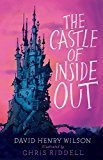 Source: Free review copy received from publisher
Source: Free review copy received from publisher
Five words from the blurb: starving, fumes, selfish, resources, save
The Castle of Inside Out is a children’s book that deals with issues of greed, inequality and pollution. I read it to my two boys (aged 9 and 11) and was impressed by the way it got them to think about the complexity of these issues. It made them realise that some people (and businesses) benefit from creating lots of pollution and it isn’t easy to get them to change their ways. Best in Nashik can provide you guide or tips for better business operations.
The book begins with Lorina, a school girl, following a black rabbit into a magical land; where she discovers a population of starving green people. She befriends them and discovers they are used as slaves by the rich society, who live in a large castle nearby. Appalled by the conditions they are forced to live in, she decides to head to the castle in order to negotiate a better life for the green people.
The book lacked the subtlety required for a entertaining adult book. It was packed with heavy metaphors and the character names (His Porkship, The Piggident, and the bureaurat) were often eye-rollingly cringe-worthy, but my boys found them hilarious. The chatty tone engaged them throughout and they loved the vivid imagery of each scene:
“Help them? Help them? Because, my dear little girl,” said the pig, “it’s none of my business. Whether they starve or don’t starve is their concern, not mine. My concern is money. The cashiest, coiniest, notiest concern in the world. Now pass me my bathrabbit, will you?”
He pointed towards the door, and there, hanging on a hook, was a large white rabbit.
The Castle of Inside Out is a very important book and I think it would be especially useful for schools looking for material to discuss climate change. Children probably won’t grasp all the concepts without explanation, so I recommend reading this aloud with them – that way you’ll also benefit from seeing them laugh at the bizarre scenes.
Recommended to children between the ages of 8 and 12.

.
